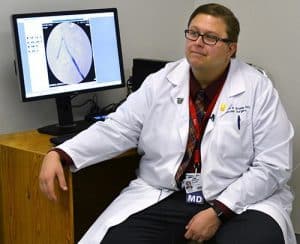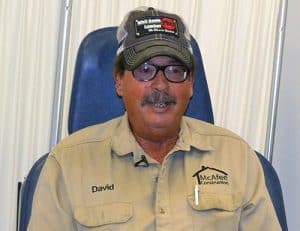Beebe Man’s Leg Pain Gone after Treatment for Artery Disease
| Nov. 3, 2015 | When David McAfee showed up in January at a free peripheral artery disease (PAD) screening put on by UAMS, he didn’t know what to expect.
All he knew is he had heard UAMS’ Matthew Smeds, M.D., on the news describing the symptoms of PAD, which sounded suspiciously like the debilitating pain he had been experiencing.
“He said your leg is going to hurt, you can’t walk, you can’t do anything,” said McAfee of Beebe. “That is what triggered me to go to the free screening.”

Matthew Smeds, M.D., shows an image of David McAfee’s artery after a stent was inserted to improve blood flow from the groin to the left leg.
Once at the screening at the Maumelle Senior Wellness Center, medical personnel took blood pressure measurements in McAfee’s legs and arms. Based on those results, Smeds recommended that McAfee come to UAMS for an ultrasound.
The ultrasound showed that McAfee had significant narrowing of the artery going from the groin into his leg, said Smeds, an assistant professor in the UAMS College of Medicine’s Department of Surgery who specializes in vascular medicine. McAfee’s condition was treated in April by placing a stent in the artery.
PAD affects between 8 and 12 million people in the United States. Risk factors for the disease include smoking, diabetes, being overweight and having high blood pressure or high cholesterol.
The narrowing of McAfee’s artery was inhibiting proper blood flow to his left leg. If it hadn’t been corrected, he risked losing his leg from the knee down, Smeds said.
McAfee has smoked for a long time and is still working to give up the habit. Knowing he could have lost his leg because of cigarettes is a powerful motivation to quit, he said.
Besides the risk of amputation, patients with PAD often have coronary artery disease that can cause a heart attack or carotid artery disease that can cause a stroke.

David McAfee said he feels 20 years younger after surgery to treat his peripheral artery disease. McAfee credits a free UAMS screening with saving his leg.
For McAfee, he immediately noticed an improvement after undergoing treatment.
“I was to the point of having to use a cane. The pain was unbelievable,” said McAfee, who added that his lack of mobility was threatening his livelihood as a contractor.
“I’m in the construction business. If you can’t walk or climb ladders, you’re out of business.”
But as he walked out of UAMS after the procedure, he felt 20 years younger. The next day, he was back at work.
McAfee said he is amazed at how good he feels now.
His sons took him to Bristol Motor Speedway in Bristol, Tennessee, this summer for his 60th birthday, fulfilling his longtime dream of seeing a NASCAR race there.
“I walked over five miles up and down hills at the speedway,” McAfee said. “Before the procedure, I couldn’t walk halfway across a room. It is unbelievable what it does.”
